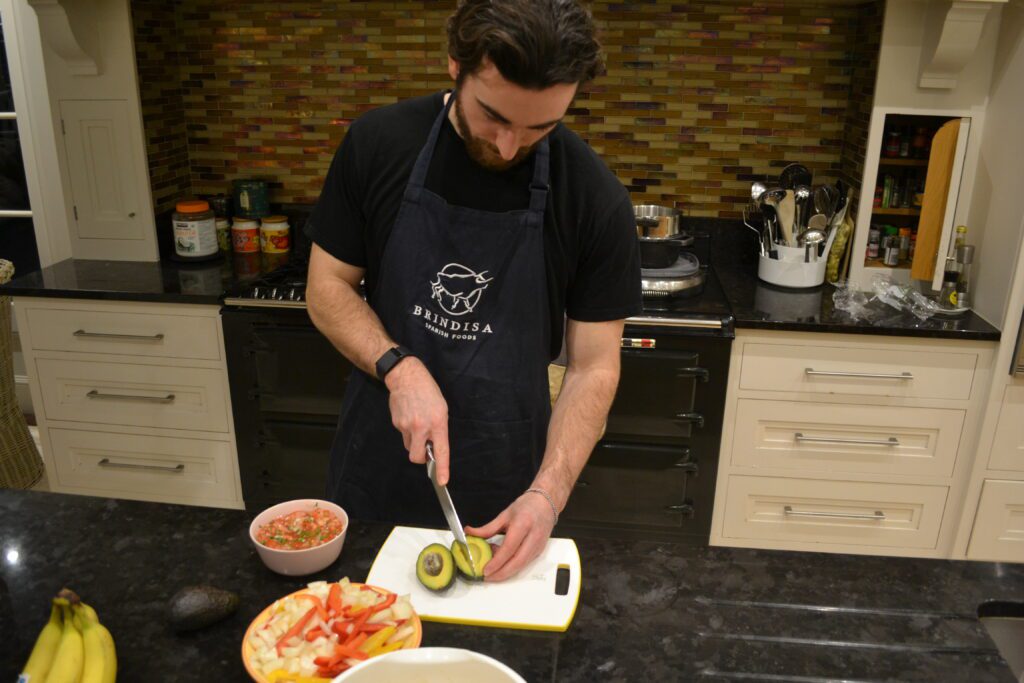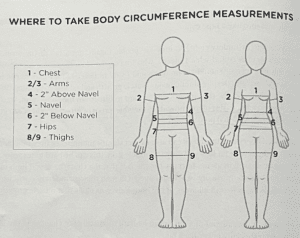Learn How to Cook meals at home
If you are serious about sustaining weight loss over the long-run, then learning how to cook balanced meals at home is an absolute necessity. Home cooking should be employed as a strategy to learn more about different food groups, macronutrients and micronutrients to allow you to make more informed decisions about the foods you eat. On top of this, home cooking can also teach you appropriate portion control to help you achieve your weight goals (weight loss, maintenance and weight gain). Rather than regularly ordering takeaway food or blindly following rigid meal plans, you can improve your health and save yourself money by learning how to integrate nutritional knowledge into your lifestyle.
Combining Home Cooking With Food Tracking Apps
Combining home cooking with food tracking apps like My Fitness Pal (MFP), will teach you how to make educated decisions about your food choices. In the below section, I’ll use my data from MFP as an example to show you how you can do this.
- Total Calories (3,703)
Goal Calories (3,658)
Here you can see that I consumed 3,703 kcals, with a goal of 3,658 kcals. This shows me that I did a good job of hitting my daily calorie goals.
Identify High Calorie Foods
We can then take a look at which foods I consumed contained the most calories (on this day).
- Olive Oil = 1,271
- Plain Bagel = 460
- Chicken Breast = 385
- Brown Basmati Rice (Uncooked) = 351
- Cream Cheese = 282
- Caramelised Onion Humous = 225
- 70% Dark Chocolate = 195
- Smoked Salmon (100g) = 169
- Clear Whey Isolate – Bitter Lemon = 166
- Peeled Brussel Sprouts = 102
- 1 Tablespoon (of something else) = 64
Asparagus = 30
As you can see, olive oil alone contributed over 1000 calories here (119 kcals per tbsp). Therefore, if I decide on January 1st (new year, new me) that my new goal is to lose 2kg, I can use this information to my advantage by reducing my olive oil intake throughout the day. Reducing my olive oil intake by 5 tbsp for example, will save me around 600 calories.
Identify Nutrient Gaps
Using MFP, you can also take a closer look at nutrients to see where you may be falling short in certain departments. For example, looking at my fibre intake, of the 26g consumed, we can see which foods contained the most fibre.
- Peeled Brussed Sprouts = 8g
- Caramelised Onion Humous = 4g
- Plain Bagel = 4g
- 70% Dark Chocolate = 3g
- Brown Basmati Rice = 3g
- Asparagus = 2g
Total = 26g (Target 38g)
Looking at the above data, we can see that there is a clear absence of fruit and veg. This indicates that I need to increase by daily consumption of fruit and fibrous veg and keep an eye on my intake to make sure this isn’t a regular occurrence. You’d be surprised how easily we slip into new habits that may lead to nutrient deficiencies.
Learn About Macronutrients
Using MFP, you can also look at the Macros breakdown which shows the % splits of protein, fat and carbohydrates consumed.
- Protein = 196g (Target 237g)
- Carbs = 222g (Target 332g)
Fats = 231g (Target 169g)
Looking at my data, you can see that I consumed 196g of protein (adequate for my goal), and consumed enough fats/carbs to meet my daily calorie goal (3,658 kcals). Personally, I’m an advocate for hitting your protein goals, whilst remaining flexible with your fat/carb intake. I find I experience less brain fog and bloating when I consume a higher fat diet, and have learned this through the process of trial and error. I’d advise you play around with your fat and carb intake to see what feels best and helps you achieve your goals (i.e., eating more carbs may help you lift more weight in the gym). If you want to learn more about which foods you eat consume the most protein, fat and carbs, you can also unlock this data with the premium subscription (see my foods highest in protein on this day below).
- Chicken Breast = 84g
- Clear Whey Isolate – Bitter lemon = 40g
- Smoked Salmon (100g) = 23g
- Plain Bagel = 16g
Brown Basmati Rice = 8g
When you consider that I gained all this insight from 1 day of data, you can start to see how valuable these tools can be from an educational standpoint, when combined with home cooking.
Eat Foods That You Like
If you are reading this I’m sure you have friends or a family relative who are following some sort of “diet” or “meal plan”. These have become increasingly common, and the internet is littered with new diet fads that promise quick fixes and rapid weight loss. Whilst diets and rigid meal plans can work for short term results, they fail to take into account individual preferences, food intolerances and allergies. A “diet” will be far less sustainable over the long-run if it consists of foods that you dislike and/or cause symptoms of bloating, lethargy and brain fog.
Following diets and meal plans can be avoided by developing better awareness of the different food groups, which are separated by the combination of macro- and micronutrients they provide. As referenced above, apps like MFP can be used as educational tools alongside home cooking to improve your awareness of different foods. Once you have learned about different macros, micronutrients and mastered better portion control, personal choice within each food group can be implemented. As you will discover in the next section, the choices within each group are vast and the best recommendation is to choose the foods you prefer, can afford and can consistently access on a weekly basis.
Design Your Own Personal “Healthy” Food Guide
- Asparagus
- Bean Sporouts
- Bell Peppers
- Broccoli
- Brussel Sprouts
- Cabbage
- Cauliflower
- Celery
- Cucumber
- Aubergine
- Green Beans
- Green Leafy Vegetables
- kale
- Leeks
- Lettuce
- Onions
- Spinach
- Tomatoes
- Butternut Squash
- Courgettes
Root Vegetables (tend to be slightly higher in starch):
- Artichokes
- Beetroot
- Carrots
- Celeriac
- Garlic
- Parsnips
- Potatoes
- Radishes
- Sweet Potatoes
- Turnips
- Yams/Yuca
Legumes:
- Kidney Beans
- Black Beans
- Pinto Beans
- Cannellini Beans etc.
- Lentils
- Chickpeas
*These foods are high in protein and make great protein substitutions in plant based diets.
Grains:
- Barley
- Breads (Wholegrain, Sourdough etc.,)
- Buckwheat
- Millet
- Oatmeal
- Pasta
- Quinoa
- Rice
Fruit:
- Apples
- Bananas
- Blueberries
- Melon
- Cherries
- Coconut
- Grapes
- Kiwis
- Lemons & Limes
- Mangoes
- Peaches
- Pears
- Pineapple
- Plums
- Rasberries
- Strawberries
- Grapefruit
Animals Proteins:
- Cheeses
- Chicken
- Cottage Cheese
- Duck
- Eggs & Egg Whites
- Greek Yoghurt
- Lamb
- Minced Meat (Beef, Pork, Lamb etc.)
- Organ Meats (Liver, Heart etc,)
- Pork
- Salmon
- Shellfish
- White Fish (all kinds)
- Tuna
- Turkey
- Game Meats (Venison, Pigeon etc).
Plant Based Proteins:
- Legumes
- Nuts
- Seeds
- Vegan Cheeses
- Tofu
Fat Sources:
- Avocados
- Avocado Oil
- Coconut Oil
- Butter
- Ghee
- Nuts
- MCT Oil
- Olives
- Extra Virgin Olive Oil
- Seeds (Sesame, Sunflower, Chia, Flax, Pumpkin)
- Cheeses
- Dark Chocolate
- Fatty Fish (Salmon)
- Full Fat Yoghurt (Greek)
*Nuts are best consumed raw
As you can see, this is a comprehensive list of different “heathy” foods that you can choose from to form a balanced diet. With the aforementioned tools and guidance, I want you to teach yourself how to navigate your nutrition on your own, and build yourself a flexible food guide with a variety of different and delicious foods.









4 Responses
Super useful and a really clear breakdown of food groups, thank you!
Glad you thought so Juli! Thanks for the feedback 🙂
Very insightful, I will be using this to help alter my shopping list!
Glad to hear! Stay clear of the dairy isle 🙂